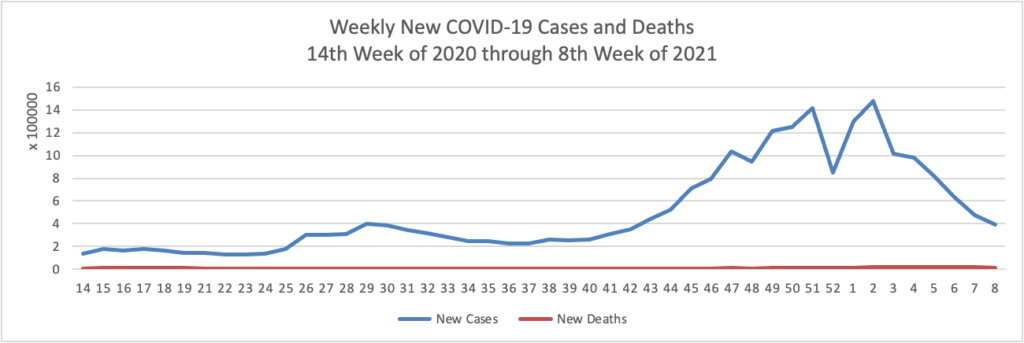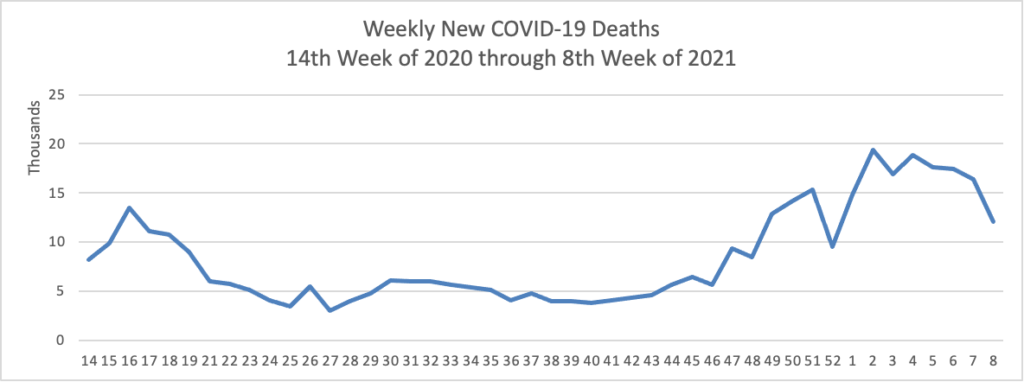Based on the Centers for Disease Control’s COVID-19 Data Tracker website, here is the FEHBlog’s chart of new weekly COVID-19 cases and deaths over the 14th week of 2020 through 8th week of this year (beginning April 2, 2020, and ending February 24, 2021; using Thursday as the first day of the week in order to facilitate this weekly update):

and here is the CDC’s latest overall weekly hospitalization rate chart for COVID-19:

In this regard, Bloomberg reports that
Covid-19 hospital admissions plummeted 72% in a month in the U.S. as the virus ebbed and the vaccination push accelerated.
Americans 85 years old and over saw the most pronounced drop, down 81% from January to February, according to the U.S. Centers for Disease Control and Prevention, which monitors the data through its Covid-19-Associated Hospitalization Surveillance Network.
The rate was 23.4 hospitalizations per 100,000 residents 85 and over for the week of Feb. 7-13, the latest data available. That was down from 120.3 per 100,000 four weeks earlier. The overall rate across age groups was 4.6, down from 16.7.
The FEHBlog has noticed that the new cases and deaths chart shows a flat line for new weekly deaths because new cases greatly exceed new deaths. Accordingly here is a chart of new COVID-19 deaths over the period (April 2, 2020, through February 24, 2021):

Finally here is a COVID-19 vaccinations chart for past ten weeks which also uses Thursday as the first day of the week:

In other COVID-19 vaccination news
- The Wall Street Journal reports that
Johnson & Johnson’s JNJ -2.64% single-dose Covid-19 vaccine worked safely and should be authorized for use in the U.S., a panel of experts advised federal health regulators Friday. The advisory committee’s unanimous vote in support of the vaccine’s authorization is the last step before the U.S. Food and Drug Administration issues a decision, which is expected Saturday.
Yippee!
- Reuters reports that “The U.S. Food and Drug Administration on Thursday approved storage and transportation of COVID-19 vaccine developed by Pfizer Inc and German partner BioNTech SE at standard freezer temperatures for up to two weeks instead of ultra-cold conditions. * * * “Alternative temperature for transportation and storage will help ease the burden of procuring ultra-low cold storage equipment for vaccination sites and should help to get vaccine to more sites,” Peter Marks, director of the FDA’s Center for Biologics Evaluation and Research, said.
In other COVID-19 news
- The AP informs us that “February is usually the peak of flu season, with doctors’ offices and hospitals packed with suffering patients. But not this year. Flu has virtually disappeared from the U.S., with reports coming in at far lower levels than anything seen in decades.” It’s a silver lining in the COVID-19 cloud.
- The Centers for Medicare and Medicaid Service released updated guidance today for health plans, including FEHB plans, on coverage of COVID-19 testing and vaccinations.
- Bloomberg reports that
States should maintain Covid-19 restrictions such as mask wearing and capacity limitations as case numbers halt their decline, the head of the U.S. Centers for Disease Control and Prevention said Friday, citing the circulation of new variants and infection rates that remain alarmingly high.
CDC Director Rochelle Walensky issued a sobering warning during a press briefing Friday, where she said the more contagious B.1.1.7 variant, first found in the U.K., now accounts for an estimated 10% of current U.S. cases, and that variants in California and New York also appear to spread more easily.
“Things are tenuous — now is not the time to relax restrictions,” Walensky said. “The latest data suggest that these declines may be stalling, potentially leveling off at still a very high number. We at the CDC consider this a very concerning shift in the trajectory.”
- STAT News punctured a CDC recent statistic as follows:
The Centers for Disease Control and Prevention made headlines last week when it announced that Covid-19 had reduced the average life expectancy of Americans in 2020 by a full year. The news seemed to starkly illustrate the devastation wrought by our nation’s worst public health crisis in 100 years.
But there was a problem. The pandemic’s appalling toll could not have reduced life span by nearly that much. My own estimate is that when Covid-19’s ravages in 2020 are averaged across the country’s entire population, we each lost about five days of life.
The CDC’s mistake? It calculated life expectancy using an assumption that is assuredly wrong, which yielded a statistic that was certain to be misunderstood. * * * The CDC’s report boils down to a finding that bears no relation to any realistic scenario. Running the 2020 gauntlet for an entire life results in living one year less on average than running that same gauntlet in 2019.
In other healthcare news, Fierce Healthcare informs us that
Cigna will acquire telehealth platform MDLive, the insurer announced Friday morning.
Cigna has been a longtime partner of and investor in MDLive and will fold it into its Evernorth subsidiary, which houses its health services business. The deal is expected to close in the second quarter of 2021, pending regulatory approvals.
Cigna said that it expects to deliver $20 in earnings per share this year, including impacts of the acquisition, and will present additional details about the deal at its investor day on March 8.
Finally, the FEHBlog has been continuing to review the draft Postal Service bill creating a Postal Service Health Benefits Program. He has updated Wednesday’s post on the topic and he wishes to point out an important clarification on how the bill would treat Postal Service annuitants. Per the Committee staff memorandum:
The bill would require future retirees to enroll in Medicare in order to participate in the Postal Employee Benefits Program (similar to the Federal Employee Health Benefit Program but established as a separate risk pool). However, the bill includes several exceptions:
- Residents of foreign countries and others without access to Medicare providers would not automatically be enrolled in Medicare; and
- Retirees who do not have the requisite 40 quarters of creditable service would not be automatically enrolled in Medicare. This would include many Civil Service Retirement System (CSRS) retirees.
- In addition, current retirees would be granted a three-month grace period from the Medicare penalty for late enrollment but would not be required to enroll.
This helps explain why NARFE is willing to support the bill.
